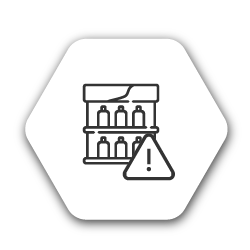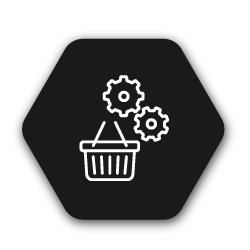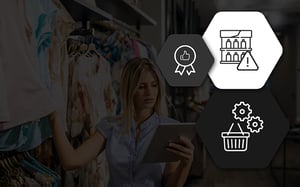Merchandising is described as the actions of promoting the sales of goods in stores, through the presentation thereof. This is important for the success of any retailer as it plays a vital role in influencing a consumer’s decision to make a purchase and it is often referred to as the ‘silent salesperson’.
Planogram or POG merchandising, meanwhile, can help you to achieve your category objectives.
A planogram can also help you to effectively communicate your category objectives to be implemented in store. In this article, we look at why merchandising is important and the role that planograms play in bringing merchandising plans to life.
Why is merchandising important?
Merchandising plays a pivotal role in presenting products to your consumers in the right place, at the right time, in the right quantity at the right price. In doing so, you influence the consumer’s decision to make a purchase.
Let's consider an example: when a shopper goes to a store to purchase an item such as soap, they are more inclined to opt for the item that they are presented with first. Therefore, eye-level shelf space is optimal placement and as a retailer, this should be reserved for items that will contribute to obtaining the objectives for the category. From a supplier’s point of view, this is the desired shelf space for your items as they are most likely to sell.
Merchandising is important for the success of all retailers - online as well as brick-and-mortar stores. When it comes to costs associated with stock holding, the carrying cost of inventory is at the top of the list as one of a retailer’s biggest expenses. For this reason, brick-and-mortar stores should pay extra attention to their merchandising to ensure that they can reduce the costs associated with inventory holding.
Consumers are becoming more educated and the market is becoming more competitive as online retail is now playing a bigger role than ever before. To remain relevant as a retailer, you need to be proactive and stay ahead of the market. This is where data-driven merchandising comes into play. As a brick-and-mortar store, it is pivotal to make the in-store shopping experience a pleasant one.
Consider your consumer decision tree when planning your merchandise placements as this is how your consumers shop your store and without it, inconsistent product layouts across stores will lead to confusion and loss in sales.
Suppliers also have a role in merchandising as they have access to market data that retailers don’t necessarily have access to. This allows them to make suggestions surrounding the placement of products based on how they perform in the market. Therefore, there is significant value in a supplier-retailer category management collaboration. Suppliers also then have the benefit of gaining influence over the shelf placement of their products.
Planograms as a merchandising tool
You might be wondering how it is possible to plan your merchandise displays while keeping your data analysis findings as well as your category strategies in mind and then communicating this to the relevant role players.
Planograms are data-driven merchandising tools that indicate the placement of products on a shelf. They are created by a shelf planner using planogram software and distributed to the relevant people to ensure that they are implemented as planned so that your retail goals are met.
Why are planograms used for merchandising?
Planograms are effective to communicate shelf plans to stores as they provide a visual layout of the shelf. Planograms are created for each category to ensure that they are in line with the category role and strategy and the placement of each individual item is considered carefully.
Using specialised software to create your planograms is the best way to ensure that your shelf plans are data-driven so that you can have the perfect balance between consumer demand and product sales and that this can be communicated easily and effectively.
How are planograms used for merchandising?
Planograms are used to illustrate merchandising techniques that are in line with the strategies for the category. They are designed through careful consideration of product placement and use product and fixture dimensions as well as images to create a realistic visual of the shelf.
Planograms allow you to communicate your shelf plans to stores in an organised manner with minimal risk of confusion. This will help you to ensure that these well-thought-out and carefully considered space plans are implemented as intended at store level so that the results can be achieved as expected.
Best practices for POG merchandising
1. Data Analysis
Space planning software helps retailers gain insight through data analysis to determine exactly which products are selling and where it would be more profitable to cut certain product lines from your range. Space planning software processes data to provide you with metrics such as days of supply, best selling items and unit movement.
This allows you to make informed decisions about the quantities you should be stocking to avoid excess inventory or running out of stock. Remember, selling space is money and therefore it must be fully optimised to maximise your profit.
2. Consider Your Merchandising TechniquesMerchandising is more than a random product placement, this is carefully planned with the merchandising strategies for the category in mind. Merchandising strategies such as traffic building, profit generating and image enhancing are developed according to the category role.
Once you have decided on your merchandising strategy for the category, this will form your base for the techniques that you will use to bring your merchandising strategies to life.
3. Make use of Planogram ReportsOnce your planogram has been created, highlights and reports can be used to justify your placement decisions, for comparison or to accompany your planogram to ensure effective implementation.
DotActiv’s planogram software allows you to apply highlights to your planogram to indicate metrics such as the days of supply and where best selling and worst selling items are placed.
DotActiv’s planogram reports such as the custom graph, will help you to analyse your placement decisions and make improvements to your planogram if and where necessary.
The Plano and Shelf report or the Split plano and shelf report are great to share to merchandisers in-store as they are fully customisable and they describe product placement effectively.
4. Planogram Communication and Implementation ConfirmationOnce your planograms have been created, one part of the job is done. It is important that planograms are communicated to stores without confusion or any hold ups so that they can be implemented as planned.
Planogram communication software such as DotActiv’s Activ8 simplifies this process and minimises the risk of error. Activ8 integrates directly with our planogram software so that planograms can be communicated effectively and the implementation process can be streamlined.
Activ8 allows for two way communication and planograms can be marked as implemented in store. Any feedback and live photos can be uploaded for review.
There is no point in planning your merchandising if it cannot be communicated and implemented correctly. Effective planogram communication will cancel out the opportunity for error and ensure that there is layout consistency across your retail stores.
Conclusion
Activ8’s planogram communication and implementation software is designed for retailers who need to manage their planogram implementation across one or multiple stores. With Activ8 software, you can drive clear communication, transparency, and accountability in a structured manner.
If your business needs software to ensure the effective communication of planograms and tracking the implementation thereof, sign up to Activ8 for free for the first four months. Your first 20 users will remain free ongoing.


